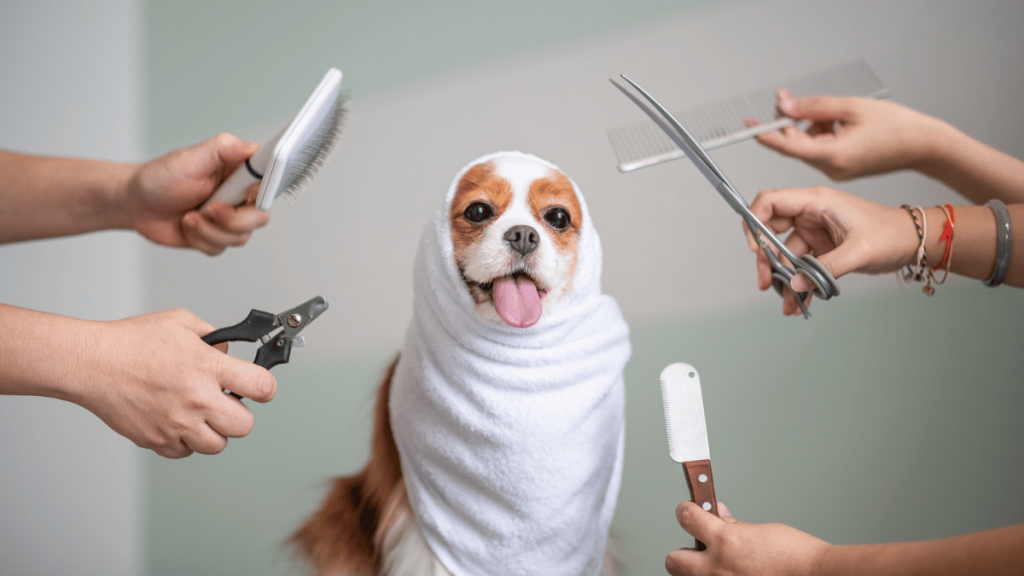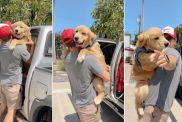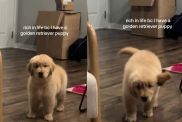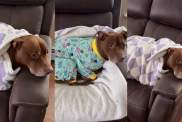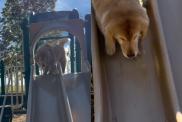Choosing the right dog grooming kit isn’t just about finding the one with the most tools or the highest ratings — it’s about what works best for your dog. What works for your dog probably won’t work for your neighbor’s. It doesn’t matter if you’re tackling tangles, trimming nails, or giving your pup a full at-home spa day; the right grooming kit can make all the difference in keeping your pup clean, healthy, and happy.
It’s a good thing, then, that there’s no shortage of options in the market — from compact kits for quick touch-ups to full grooming vacuums and professional-grade shears. The important thing to consider is your dog’s breed, coat type, and grooming needs. A double-coated Husky will need very different tools than a short-haired Beagle or a curly-coated Poodle. And for some dogs, a dedicated dog hair dryer might be just as essential as a slicker brush or nail grinder.
In this comprehensive buying guide, we’ll walk you through what to look for in a dog grooming kit. By the end of this article, you’ll know which tools — clippers, vacuums, dryers, and beyond — are truly worth the investment for your breed.
Understanding Your Dog’s Grooming Needs
Before you invest in any tools, it’s always a good idea to understand how often your dog needs grooming and what kind. A Labrador that sheds all year will need to be deshedded on a regular basis, while a Shih Tzu or Poodle will need to be trimmed often to keep mats from forming. Check the type of coat your dog has, how much they shed, and whether they have sensitive skin or get tangles easily.
Long-haired or double-coated breeds, like Huskies or German Shepherds, often benefit from regular blowouts using a dog dryer or pet dryer — when used correctly and at the right time, they can help prevent painful mats and reduce shedding in your home. For shorter-coated breeds, brushing, nail cutting, and an occasional bath may be all they need.
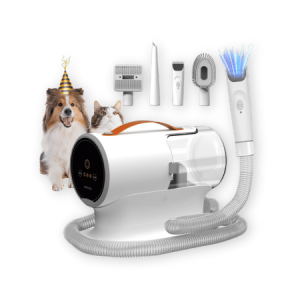
Best Dog Grooming Kits With Vacuums in 2025
Discover the top dog grooming kit with vacuum!
What Should a Good Dog Grooming Kit Include?

A good dog grooming kit should have everything you need to do basic grooming on your pet from head to tail. These are the most important things to look for:
Brushes for Your Dog’s Coat Type
Slicker brushes are helpful for getting rid of knots, and de-shedding tools are great for keeping loose fur under control, especially in double-coated breeds like Huskies or Labs.
Nail Clippers or Grinders
Keeping your dog’s nails trimmed helps prevent joint strain and floor damage. If you’re a beginner, look for tools that include safety guards.
Scissors and Trimming Shears
Helpful for fine-tuning around the face, paws, and tail, especially for long-haired breeds.
Clippers With Different Guard Combs
A must for trimming thick coats. If you trim your dog often, buy a good clipper that doesn’t make too much noise and doesn’t become too hot.
Comb
A metal comb helps with detangling, finishing, and checking for fleas or skin issues.
Dog Hair Dryer or Dog Blow Dryer
Look for one that is safe for pets and lets you change the heat and airflow. A good pet dryer cuts drying time and also reduces matting.
Grooming Vacuum
If you have a heavy shedder or a large dog, the best dog grooming kit with vacuum features can save you major cleanup time. Some kits even come with a pet grooming vacuum attachment for collecting loose fur as you brush.
Storage Case
This keeps everything neat and easy to carry, which is great if you’re grooming on the move.
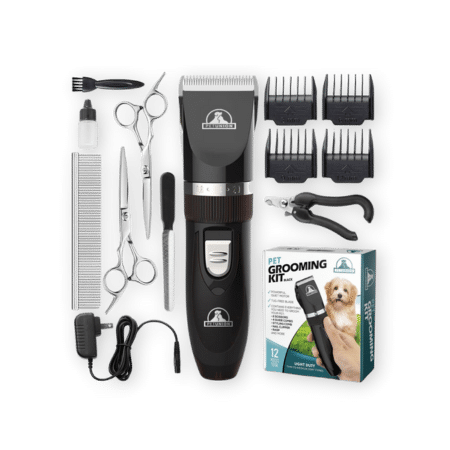
Best Dog Grooming Kits for Long-Coat Breeds
Find the best grooming kits for long-coat breeds!
Breed-Specific Grooming Tools to Consider
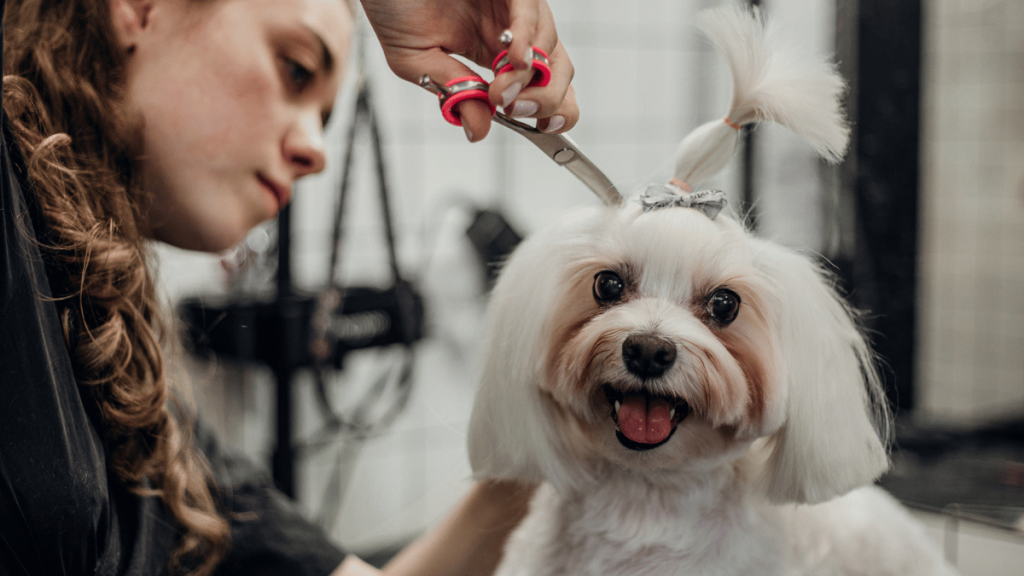
Once you understand your dog’s general grooming needs, the next step is to dive into the specifics of their coat type. Different breeds have evolved with unique coats that require particular tools to keep them healthy, comfortable, and looking their best.
For Dogs with Long, Silky, or Feathered Coats (e.g., Shih Tzu, Golden Retriever, Afghan Hound, Cavalier King Charles Spaniel)
- Pin Brush: A must-have for general brushing, detangling, and preventing mats without pulling too much hair. Look for pins with rounded ends to protect the skin.
- Slicker Brush: Great for getting rid of stray hair, small tangles, and smoothing the coat. Use it gently to avoid “brush burn.”
- Wide-Tooth Comb: Perfect for working through tangles and mats, especially after using a slicker or pin brush. Helps ensure no hidden knots.
- Dematter or Mat Splitter: For mats that won’t come out with a brush. Use with great care and never on the skin.
- Grooming Shears (Blunt-Nosed): For trimming around eyes, paws, and sanitary areas. Blunted tips add an extra layer of safety.
- High-Velocity Dog Hair Dryer/Dog Blow Dryer: Crucial for thoroughly drying these coats after bathing to prevent matting and skin issues. A powerful pet dryer will significantly reduce drying time.
For Dogs with Double Coats (e.g., Siberian Husky, German Shepherd, Samoyed, Border Collie)
- Undercoat Rake: Absolutely vital for reaching and removing loose hair from the dense undercoat. This is a game-changer for shedding seasons.
- Deshedding Tool (e.g., Furminator-style): These tools are made to grab and remove a lot of dead undercoat, which cuts down on shedding by a lot.
- Slicker Brush: You can use it on the topcoat to smooth it out and get rid of surface shedding.
- Grooming Vacuum: These breeds are heavy shedders, and a grooming vacuum will capture loose hair directly from the source, minimizing mess. Look for options like the Neabot pet grooming kit or other pet grooming vacuum kits that include deshedding attachments. The quietest pet grooming vacuum might be a priority for sensitive pups.
- Powerful Dog Dryer: Essential for thoroughly drying their thick coats after bathing to prevent dampness that can lead to skin problems.
For Dogs with Curly or Wavy Coats (e.g., Poodle, Bichon Frise, Portuguese Water Dog, Goldendoodle)
- Slicker Brush: Daily brushing with a good quality slicker brush is key to preventing mats from forming in their tight curls.
- Metal Comb (Coarse and Fine Teeth): Use to meticulously work through curls and check for any remaining tangles after brushing.
- Grooming Shears/Clippers: To keep their coat at the right length and shape, many curly-coated breeds need to be clipped regularly. Invest in good-quality clippers with various blade sizes.
- Detangling Spray: Helpful for loosening knots before brushing, making the process more comfortable.
- High-Velocity Pet Dryer: Essential for fluff drying and shaping their coats. The airflow helps to straighten the curls for easier brushing and trimming.
For Dogs with Short, Smooth Coats (e.g., Boxer, Beagle, Dalmatian, Bulldog)
- Rubber Curry Brush or Grooming Mitt: Excellent for massaging the skin, stimulating circulation, and removing loose hair and dander. Works wonders during bath time too.
- Bristle Brush: Helps to polish the coat, distribute natural oils, and add shine.
- Shedding Blade: While not always necessary, a shedding blade can be used during heavy shedding seasons to quickly remove loose hair.
- Grooming Vacuum (with pet grooming vacuum attachment): Even short-haired dogs shed. A lightweight grooming vacuum can be a quick and easy way to remove loose hair and keep your home cleaner.
For Dogs with Wiry Coats (e.g., Terrier breeds like Westiepoo, Schnauzer, Airedale Terrier)
- Stripping Knife: For hand-stripping, which is traditional for many wiry-coated breeds to maintain coat texture and color. This is an advanced technique often best learned from a professional.
- Bristle Brush: For regular grooming to remove loose hair and keep the coat tidy.
- Slicker Brush: Can be used for light detangling if needed.
- Combs: To make facial hair and beards seem neat.
Tips for Grooming Dogs with Sensitive Skin
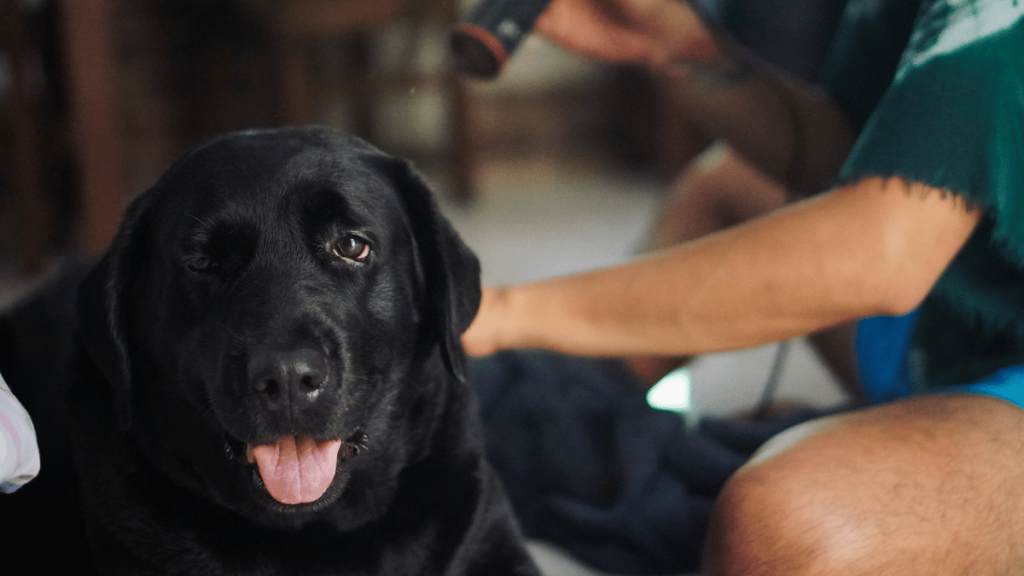
If your dog has sensitive skin, gentle handling and the right tools can make a big difference. Here are some helpful tips:
Use Hypoallergenic Shampoos
Choose fragrance-free or vet-recommended formulas made for sensitive skin to avoid irritation.
Brush With Soft Bristles
Go for a gentle brush or grooming glove to avoid scratching or aggravating the skin.
Skip Harsh Grooming Tools
Avoid sharp or metal tools that could cause microtears or discomfort during grooming.
Choose a Quiet Grooming Vacuum
A loud motor can stress out sensitive dogs. The quietest pet grooming vacuum can make the process calmer and more comfortable.
Use a Pet-Safe Dog Dryer
A dog hair dryer or dog blow dryer with adjustable heat and airflow is ideal. Too much heat can dry out the skin, so choose a pet dryer with cool or low settings.
Keep Grooming Sessions Short and Sweet
Don’t overdo it. Break up the grooming process into smaller sessions to prevent stress or discomfort.
Check for Redness or Bumps
Always inspect your dog’s skin after grooming to catch any reactions early and adjust your routine if needed.
Maintaining Your Grooming Tools
A good pet grooming vacuum kit or clipper set will only last if you take care of it. Clean blades after every use, regularly remove fur buildup from brushes, and replace dull scissors. For vacuums, make sure the filter and collection bin are emptied and cleaned often.
Some of the best pet grooming vacuums come with self-cleaning brushes or parts that come off so that maintenance is easier. And if your dog dryer or pet grooming vacuum attachment seems to lose power or heat, check for clogs or wear and tear before replacing it.
Setting Up Your Home Grooming Space
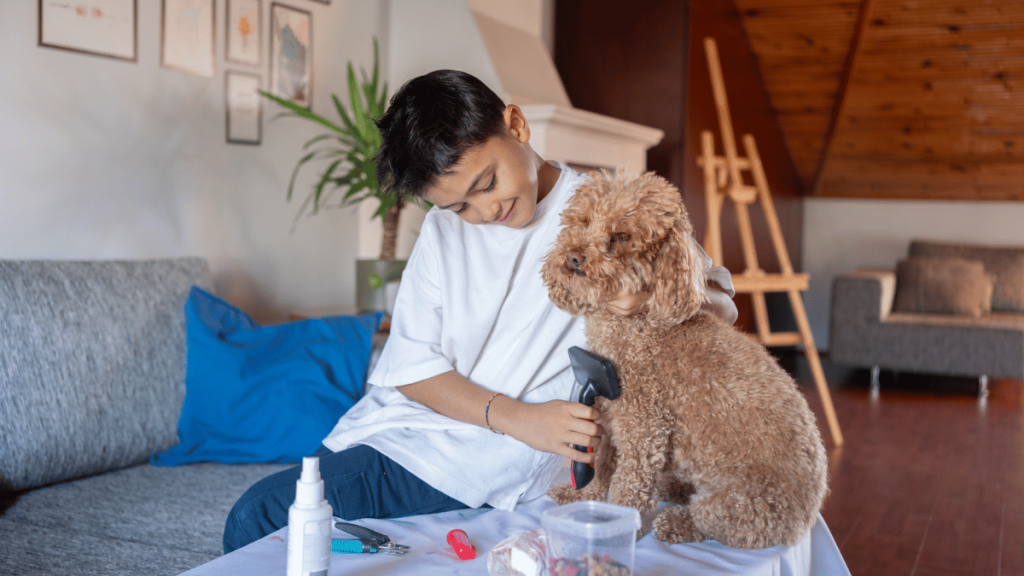
If you can create a dedicated, stress-free grooming area at home, it can really make the process easier for both you and your dog. Here’s how to get started:
- Choose a Low-Traffic, Well-Lit Area: A calm space with good lighting helps you see what you’re doing and keeps your dog from getting distracted.
- Lay Down a Non-Slip Mat: Dogs feel more secure when they’re not slipping around. A rubber mat or textured rug can provide stable footing.
- Keep All Your Tools Within Reach: Store brushes, clippers, scissors, and your dog hair dryer in a nearby drawer or grooming caddy to avoid interruptions.
- Have Towels and Cleaning Wipes Handy: These help with messes and quick cleanups, especially if you’re using a pet dryer or giving a full bath.
- Ensure Access To Power Outlets: For clippers, dryers, or your best dog grooming vacuum, make sure your space has outlets nearby to avoid extension cords.
- Add Treats and Calming Aids: Keep some treats, a lick mat, or even a favorite toy nearby to reward calm behavior during grooming sessions.
- Use a Portable Table or Grooming Arm if Needed: Especially helpful for small to medium dogs, a grooming table keeps them at a comfortable working height.
How Often Should You Groom Your Dog at Home?
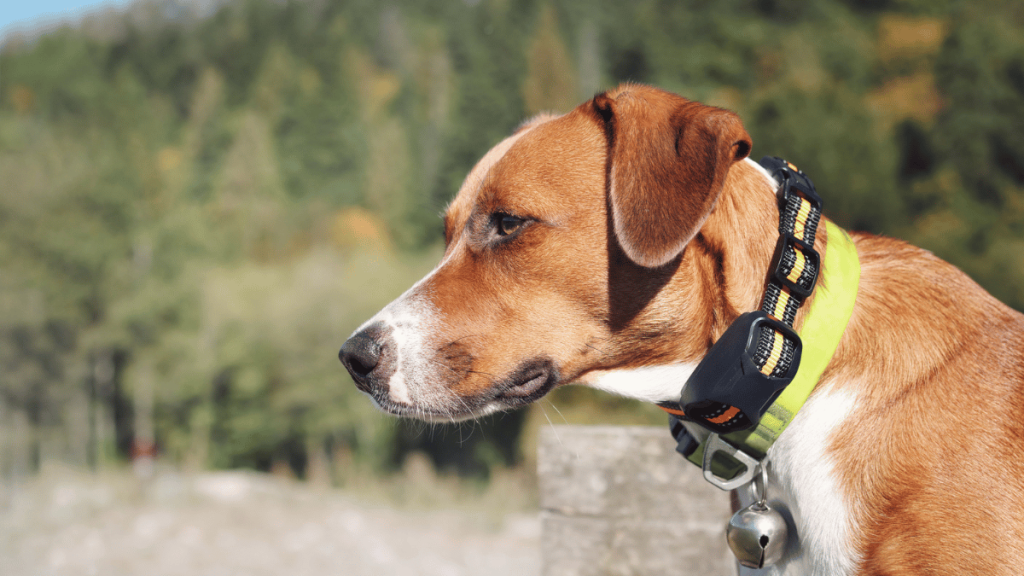
The breed, coat type, and lifestyle of your dog will determine how often they need to be groomed at home. Beagles and Boxers, for example, have short hair and may only need to be brushed once a week. Golden Retrievers and Huskies, on the other hand, have long hair or double coats and may need to be groomed several times a week to keep their hair from matting and falling out. If your dog spends a lot of time outside, you may need to give them additional washes and brush-outs to keep their skin and hair clean.
For high-shedding dogs or larger breeds, using tools like a grooming vacuum or best dog grooming vacuum for large dogs can help manage fur buildup between deep grooming sessions. Regular brushing combined with a dog dryer or pet dryer after baths can keep your dog’s coat in top shape and make full grooming days easier to manage. As a general rule, brushing 2–3 times per week and a full grooming session every 4–6 weeks is a good starting point for most dogs.
FAQ
How do I know which grooming tools are right for my dog’s breed?
Start by considering your dog’s coat type. Long-haired and double-coated breeds need de-shedding tools and dryers, while short-haired dogs may only need simple brushes and clippers. Breed-specific needs really guide your kit selection.
How often should I bathe my dog if I’m grooming them at home?
It depends on their coat and lifestyle. Short-haired dogs might need a bath every 4-8 weeks, while long-haired or active pups could benefit from a bath every 3-4 weeks. Always use dog-specific shampoo.
Is it worth investing in a grooming vacuum?
Yes, especially if your dog sheds a lot. A grooming vacuum helps you collect loose fur while you brush. For homes with more than one pet, this is a great pick as it makes grooming faster and less messy.
Can I use human clippers or a hair dryer on my dog?
It’s best to avoid human tools. Dog clippers are designed for their unique fur, and a dog hair dryer has specific heat settings that are safer and more efficient for a canine coat, preventing burns.
My dog hates being brushed. Any tips to make it easier?
Start slow and gently. Use lots of treats and praise. Keep sessions short, especially at first. Try different brushes to find one they prefer. Consistency and positive reinforcement are the name of the game.
What’s the most important tool for a beginner’s grooming kit?
A good quality slicker brush and a sturdy metal comb are excellent starting points for any dog owner. No matter what kind of dog you have, they work well for getting rid of loose fur and tangles.
Do I need a full grooming kit, or can I buy tools separately?
If you’re starting out, a dog grooming kit is convenient and cost-effective. But if your dog has specific grooming needs, it’s okay to build your own setup with individual tools tailored to their breed and coat.
How often should I replace grooming tools?
Replace blades and scissors if they become dull or tug at your dog’s coat. Brushes should be cleaned after every use, and vacuums or dryers checked regularly for clogs or wear to keep them working well.
